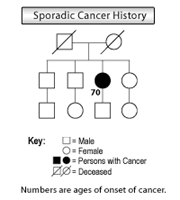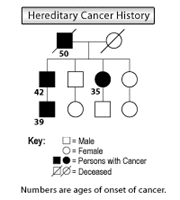Features of Inherited Cancers
Features of Inherited Cancers
Your healthcare provider may look at your family's medical history to determine whether cancer runs in your family. This means that it is hereditary. The healthcare provider may ask the following questions:
-
Do you have a history of cancer?
-
How many people in your family have cancer?
-
What type or types of cancer are present in your family?
-
Is there someone who has more than one type of cancer?
-
What are the ages that the cancer started?
-
What is the gender of your family members with cancer?
-
Are the cancers unilateral or bilateral? This means does the cancer affect just one side of the body or both. For example, cancer in both kidneys.
-
What type of environmental exposures or lifestyle factors do the people with cancer have that might have influenced their risk for cancer. For example, are they smokers?
-
How are the people with cancer related to one another?
-
Is there a vertical pattern of inheritance seen? For example, parents with cancer who have children with cancer?
-
What is the ancestry and ethnicity of your family?
All this information is recorded in the form of a family tree called a pedigree. The information is used to try to classify the family history into one of three categories. Often, other information, such as medical records or results of genetic testing may be gathered. These may help the classification process. Classifying the family history helps to determine whether relatives:
-
Have an increased chance of developing specific types of cancer
-
How great the risk of cancer might be
-
Whether genetic testing might be helpful in further evaluating cancer risks in the family
Sporadic cancer
The word sporadic means to happen by chance. Most cancers are sporadic cancers. They're caused by gene changes that take place in one cell that, with time, are passed on to new cells and can lead to cancer. Families who have a single person with cancer at an older age are usually classified as sporadic. In other words, there's no inherited pattern of cancer present. And there is often only one or two people in your family that have cancer at a typical age of onset. Relatives are usually not at increased risk of developing cancer. Genetic testing is usually not beneficial in these families.
Familial cancer
Familial cancer is when there are more cases of cancer in your family than chance alone would predict. These cancers often happen at a younger age. And they may mean the presence of a gene mutation that increases the risk for cancer. They may also be a sign of shared environmental or lifestyle factors. For example, if there seems to be a lot of lung cancer in a family and many family members smoke, the cause is not likely an inherited gene change. In general, with familial cancer, close relatives have a modestly increased risk of developing the cancer in question. There is a small chance that genetic testing will be beneficial in further assessing cancer risks.
Inherited cancer
Inherited cancer is when you have multiple family members with the same or related cancers. The cancers tend to happen at younger than average ages. This is usually younger than age 50. These cancers are often found in both of a pair of organs, like cancer in both kidneys or in both breasts.
Also, there is often a history of family members who developed two or more separate cancers. For example, ovarian cancer in a breast cancer survivor. Here are some facts about inherited cancer.
-
Families with inherited cancer often have cancer in two or more generations.
-
When a parent has an inherited predisposition to cancer, each child has a one in two chance of inheriting the predisposition.
-
People in the family who inherit the predisposition have a high chance of developing the associated cancers.
-
Those who do not inherit the predisposition are not at increased cancer risk.
Genetic testing isn't right for everyone, but it can often be helpful in figuring out who in the family has an increased cancer risk. In most cases, it's important to test a relative with cancer first to see if a mutation can be found. Identifying the mutation can help in making decisions about testing relatives who have not had cancer. It's best to talk to a genetic counselor before doing genetic testing.
Updated:
June 04, 2019
Reviewed By:
LoCicero, Richard, MD,Stump-Sutliff, Kim, RN, MSN, AOCNS


